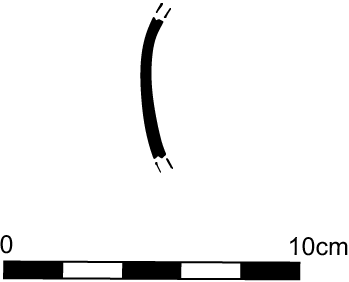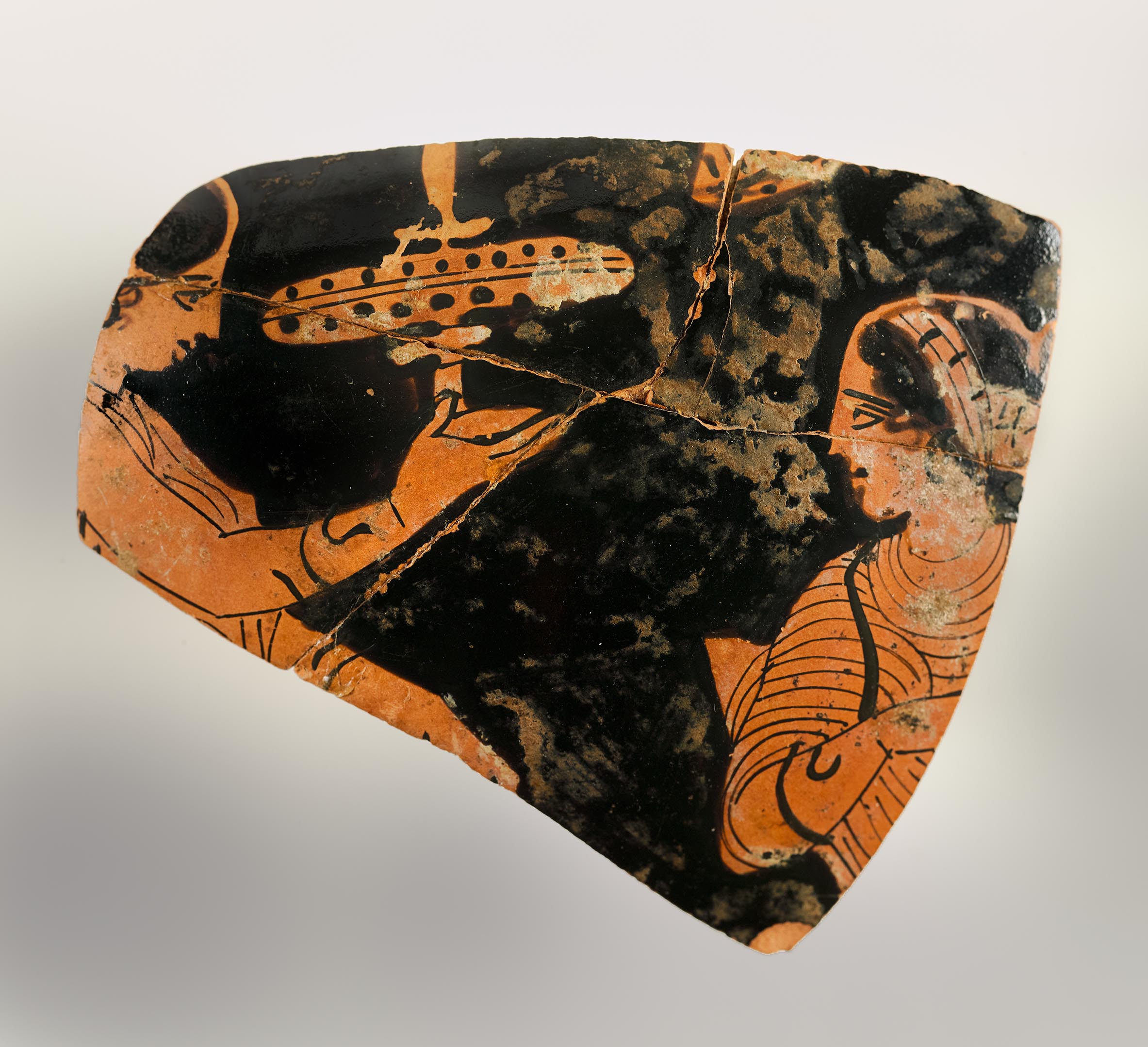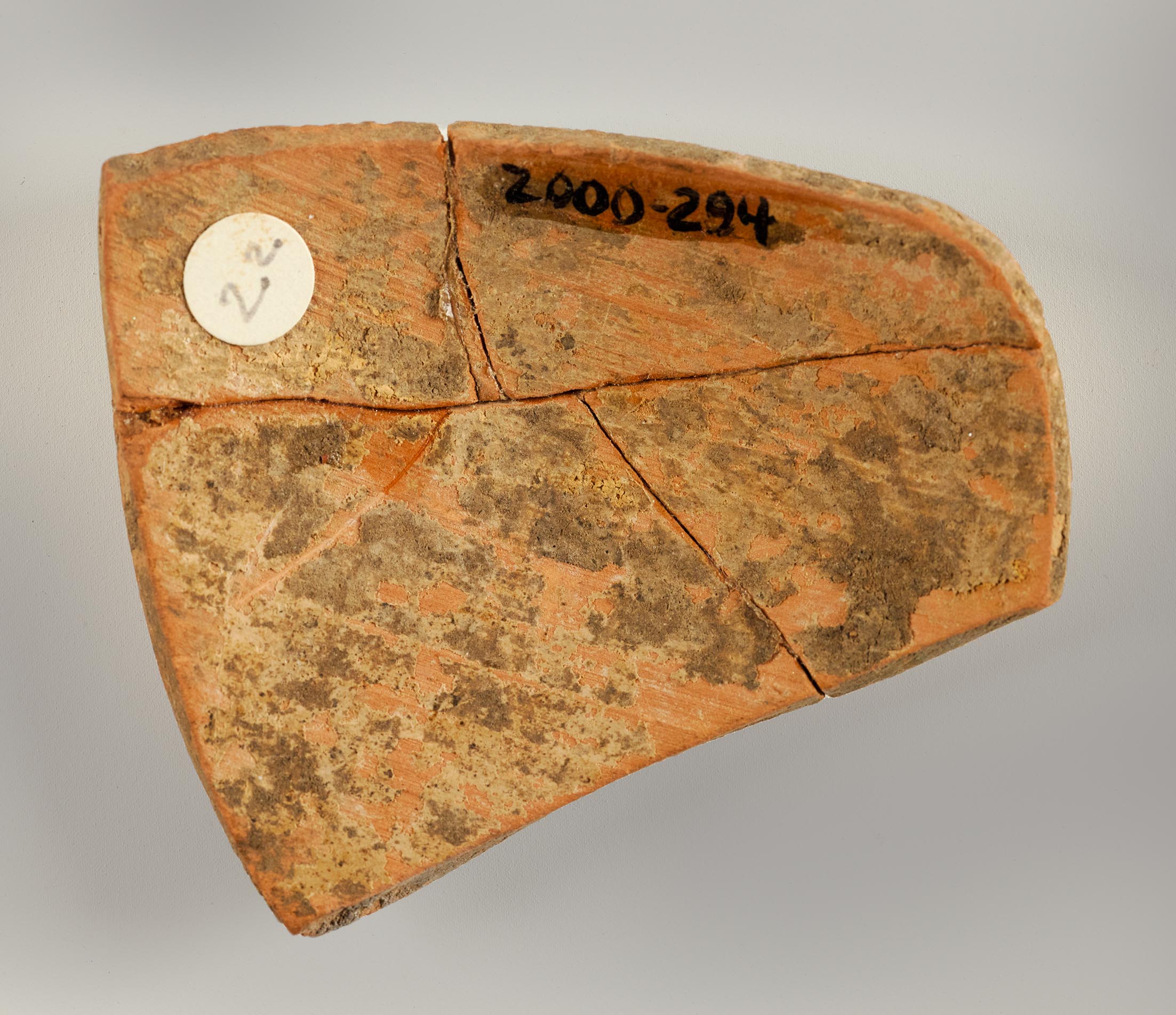Provenance
2000, gift, Sally R. Roberts (Princeton, NJ) to Princeton University.
Shape and Ornament
Single fragment from ovoid body of what is most likely a lebes gamikos. Interior reserved. No ornament preserved.

Subject
Portions of two women wearing chitons and snake bracelets. The woman at the left stands in profile to the right and holds in her raised right hand an exaleiptron decorated with dots. Her left arm is also slightly raised, and it is possible she carried something in it as well, such as a fillet or sash. At the right is a woman seated on a klismos in what is most likely a three-quarter view with her body facing right, but turning her profile head back over her right shoulder to look at the other woman. Her hair is pulled into a chignon supported by a broad bandeau. An object, perhaps a sash or a sakkos, hangs at the top of the scene.
Attribution and Date
In the manner of the Meidias Painter. Late fifth century BCE.
Dimensions and Condition
5.7 × 4.9 cm; thickness 0.2 cm. Mended from four fragments, broken on all sides. Significant incrustation on the outside, mostly between the two figures, but also on the neck and chest of the seated woman.
Bibliography
Abbreviation: Princeton RecordRecord of the Princeton University Art Museum. (1942– ). 60 (2001): 89 [not illus.].
Comparanda
The thinness and curvature of the wall suggest that the vessel was a rather squat, closed shape, very possibly a lebes gamikos, as also suggested by the subject. A large number of late fifth-century lebetes gamikoi are in the manner of the Meidias Painter: for the painter and his circle, see Abbreviation: ARV2J. D. Beazley. Attic Red-Figure Vase-Painters. 2nd ed. Oxford, 1963 1312–32, 1690, 1704, 1708; Abbreviation: ParalipomenaJ. D. Beazley. Paralipomena: Additions to Attic Black-Figure Vase-Painters and to Attic Red-Figure Vase-Painters. Oxford, 1971 477–79; Abbreviation: BAdd2Carpenter, T. H., ed. 1989. Beazley Addenda: Additional References to ABV, ARV2, and Paralipomena. 2nd ed. Oxford: Published for the British Academy by Oxford University Press. 361–63; L. Burn, The Meidias Painter (Oxford, 1987). No lebes gamikos has been attributed to the Meidias Painter himself; for those in his manner, see M. Sgourou, “Attic Lebetes Gamikoi” (PhD diss., University of Cincinnati, 1994), 135–42. The style of the figural drawing on Princeton’s fragment is simpler than on many vases in the manner of the Meidias Painter, although the facial details find parallels: cf. Athens 1659 (Abbreviation: ARV2J. D. Beazley. Attic Red-Figure Vase-Painters. 2nd ed. Oxford, 1963 1322.11; Abbreviation: BAPDBeazley Archive Pottery Database. http://www.beazley.ox.ac.uk 220560). Compositionally, the scene resembles that on other lebetes gamikoi in the painter’s circle, with a seated woman receiving gifts, including large exaleiptra, from a standing attendant: cf. Athens 1658 (Abbreviation: ARV2J. D. Beazley. Attic Red-Figure Vase-Painters. 2nd ed. Oxford, 1963 1320.1; Abbreviation: BAPDBeazley Archive Pottery Database. http://www.beazley.ox.ac.uk 220542); Athens, Benaki Museum 35420 (CVA Athens, Benaki 1 [Greece 9], 39–40, pl. 33.1–2; Abbreviation: BAPDBeazley Archive Pottery Database. http://www.beazley.ox.ac.uk 9029967). Although the seated woman in such scenes often faces forward, her backward glance toward an attendant is not without parallels: cf. the oinochoe Newcastle 295 (Abbreviation: ParalipomenaJ. D. Beazley. Paralipomena: Additions to Attic Black-Figure Vase-Painters and to Attic Red-Figure Vase-Painters. Oxford, 1971 479.44 bis; Abbreviation: BAPDBeazley Archive Pottery Database. http://www.beazley.ox.ac.uk 340045). Judging from such examples, it is likely that the scene on Princeton’s fragment continued around the vase and included other standing women bearing gifts, and possibly flying erotes. Beazley noted that vases in the manner of the Meidias Painter “differ widely from one another” (Abbreviation: ARV2J. D. Beazley. Attic Red-Figure Vase-Painters. 2nd ed. Oxford, 1963 1315), and the artist in this case could have been one of the lesser followers of the master.
The lebes gamikos seems to have functioned as a kind of standed louterion, which served as a receptacle for bathwater transported in the other major nuptial shape, the loutrophoros. For lebetes gamikoi, and in particular their connection with marriage, see D. M. Robinson, “A New Lebes Gamikos with a Possible Representation of Apollo and Daphne,” Abbreviation: AJAAmerican Journal of Archaeology 40 (1936): 507–19; Sgourou, “Attic Lebetes Gamikoi”; id., “Λέβητες γαμικοί: Ο γάμος και η αττική κεραμεική παραγωγή των κλασικών χρόνων,” in Abbreviation: Athenian Potters and PaintersAthenian Potters and Painters: The Conference Proceedings. 3 vols. Vol. 1, edited by J. H. Oakley, W. D. E. Coulson, and O. Palagia. Oxbow Monograph 67. Vol. 2, edited by J. H. Oakley and O. Palagia. Vol. 3, edited by J. H. Oakley. Oxford, 1997 (vol. 1), 2009 (vol. 2), 2014 (vol. 3), 71–83; M. B. Moore, Attic Red-Figured and White-Ground Pottery, Abbreviation: AgoraAthenian Agora (Princeton 1953– ) 30 (Princeton, NJ, 1997), 18–20. For a recent discussion of the findspots of lebetes gamikoi, see V. Sabetai, “The Wedding Vases of the Athenians: A View from Sanctuaries and Houses,” Abbreviation: MètisMètis: Anthropologie des mondes grecs anciens, n.s. 12 (2014): 51–79. The shape also has been associated with weddings on the grounds that scenes painted on them are mostly nuptial, with a seated bride receiving containers from various attendants, some of them possibly wedding gifts: bottled scents, baskets of textiles, jewel boxes, and mirrors. Flying erotes often accompany the mortal women and make the nuptial context explicit: cf., inter alia, in the manner of the Meidias Painter, Berkeley 8.48 (Abbreviation: ARV2J. D. Beazley. Attic Red-Figure Vase-Painters. 2nd ed. Oxford, 1963 1322.13; Abbreviation: BAPDBeazley Archive Pottery Database. http://www.beazley.ox.ac.uk 220562). In addition, when the shape is included in painted representations, the scenes are always nuptial.
Although only a portion of the full scene is preserved on Princeton’s fragment, the seated woman and the attendant firmly establish a domestic setting and likely the preparation for the wedding. If this is the case, the seated woman is probably the bride. On the other hand, there are no explicitly nuptial elements present, and the vase could have depicted a more generalized scene of adornment; for this distinction, see S. Lewis, The Athenian Woman: An Iconographic Handbook (New York, 2002), 142–45. For discussions of nuptial iconography, see Burn, Meidias Painter, 81–86; J. H. Oakley and R. H. Sinos, The Wedding in Ancient Athens (Madison, WI, 1993), 11–21, 43–47; Sabetai, “The Washing Painter: A Contribution to the Wedding and Genre Iconography in the Second Half of the Fifth Century B.C.” (PhD diss., University of Cincinnati, 1993), 26–128; id., “Aspects of Nuptial and Genre Imagery in Fifth-century Athens: Issues of Interpretation and Methodology,” in Abbreviation: Athenian Potters and PaintersAthenian Potters and Painters: The Conference Proceedings. 3 vols. Vol. 1, edited by J. H. Oakley, W. D. E. Coulson, and O. Palagia. Oxbow Monograph 67. Vol. 2, edited by J. H. Oakley and O. Palagia. Vol. 3, edited by J. H. Oakley. Oxford, 1997 (vol. 1), 2009 (vol. 2), 2014 (vol. 3), vol. I, 319–35; R. F. Sutton, “Nuptial Eros: The Visual Discourse of Marriage in Classical Athens,” Abbreviation: JWaltThe Journal of the Walters Art Gallery 55–56 (1997–98): 27–48; A. C. Smith, “The Politics of Weddings at Athens: An Iconographic Assessment,” Leeds International Classical Studies 4 (2005): 1–32; Abbreviation: Smith, Religion in the ArtSmith, T. J. 2021. Religion in the Art of Archaic and Classical Greece. Philadelphia: University of Pennsylvania Press., 252–64.

